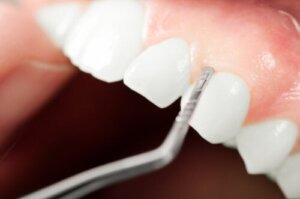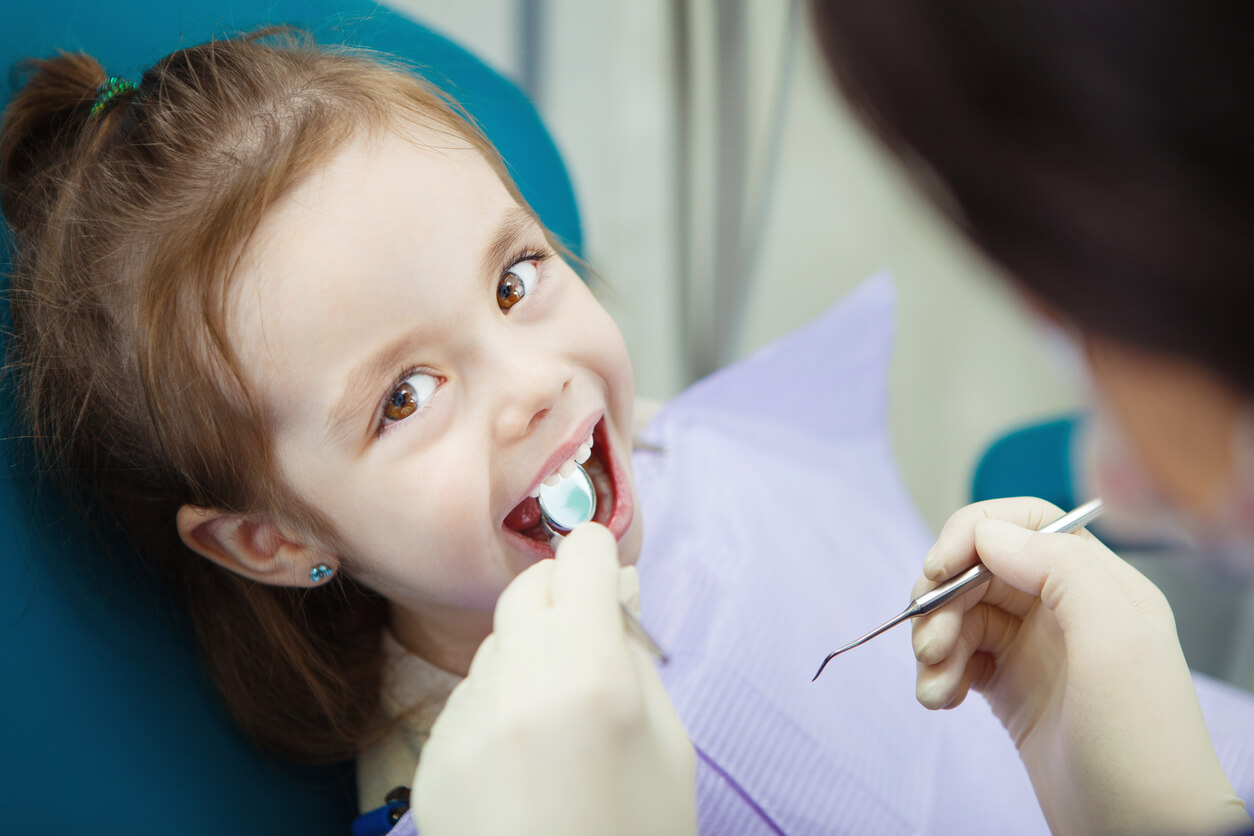Gum Loss in Children

Parents are often concerned when they notice that their children’s teeth look longer or have less gum tissue than others. So that you know what this is all about, in this article we’ll tell you what you should know about gum loss in children.
Gum loss in children usually occurs in the anterior sector of the lower arch and is generally associated with the eruption of teeth with malpositions. However, other times, it’s linked to other issues and isn’t always a problem. Read on and learn more about this situation in the mouth of little ones.
What is gum loss in children?
Gum loss in children is known as gingival recession and is the progressive thinning of the tissue covering the teeth. When this isn’t addressed in a timely manner, it can leave the tooth roots exposed and lead to some complications.
The main function of the gums is to cover and protect the root zone of the teeth, but when they recede, this protection is lost. In the early stages, it’s common not to notice any changes, but as the loss progresses, some of these manifestations may appear:
- Dental sensitivity: As the dental root is unprotected, children have discomfort when they ingest cold, sweet, or hot foods.
- Pain in the gum line.
- Inflammation and redness of the gums.
- Bad breath.
- Tooth mobility.
- Exposure of tooth roots and long tooth appearance.
As we’ve already advanced, gum loss in children usually happens in the sector of the lower incisors, and we’re going to tell you why it develops.

The causes of gum loss in children
The origin of gum loss in children isn’t the same as in adults. In older people, the most common cause is periodontal disease, but this disease isn’t common in children.
However, in small children, there are other reasons that can lead to gum loss. These are the most common ones:
- Tooth malposition: A tooth located in an inadequate place can protrude through the gums and favor its retraction. The eruption of the definitive teeth sometimes happens in a disorderly manner, especially when there’s little space. And in the attempt to “gain a place” in the arch, the dental elements affect the gums.
- Bruxism: When children unconsciously and habitually clench and grind their teeth, they exert pressure on the dental elements and surrounding tissues. This is why the gums may recede as a defense mechanism.
- Heredity: Certain genetic factors may predispose some children to gum loss. This occurs, above all, in children of adults who also suffer from the problem. In turn, it makes them more prone to developing periodontal disease.
- Aggressive brushing: Brushing teeth with too much pressure, force, and roughness leads to irritated gums that recede away from the trauma. Using a toothbrush with bristles that are too hard can also cause this effect.
The treatment of gum loss in children
Gum loss in children will be diagnosed by the pediatric dentist during the dental consultation. In any case, parents should be alert to any signs that make them suspect that their child has a problem in their mouth and consult in a timely manner.
Once the professional diagnoses gingival recession in the child, they’ll have to consider several factors before choosing how to proceed. It will be important to determine the cause, the amount of lost and remaining tissue, how much root exposure there is, and if there are associated symptoms, such as sensitivity.
The age of the patient, the position of the affected tooth, and its relationship to the other teeth and bone will also be taken into account. Also, if orthodontic treatment is foreseen in the future.
Depending on the data obtained, the dentist may consider it appropriate to maintain a watchful waiting attitude without any intervention. In these cases, regular check-ups will be carried out for a period of time to monitor the evolution. It’s a matter of watching and waiting during the period of tooth replacement, especially when the cases aren’t serious and are related to poorly positioned permanent teeth.
In some cases, orthodontic treatments will allow repositioning of the teeth that cause the problem in the gums. And over time, this will improve the situation. If the problem is caused by bruxism, splints and treatments to reduce tension in the mouth will be of great help.
If, on the other hand, your pediatric dentist decides to treat gingival recession, there are safe and effective techniques for little ones. Gum grafts or the pinhole surgical technique are some of the solutions to replace gum loss in children.

Take care of the gums as much as the teeth
Gum loss in children is often related to factors that can’t be avoided. In any case, taking care of the gingival tissue always helps to reduce the disorders.
To take care of your child’s gingival area, you must take good care of his oral hygiene. A thorough brushing that reaches teeth and gums after every meal is crucial.
This should be done gently so as not to damage the soft parts that we want to preserve. For the same reason, the brush should have soft bristles.
Complementing the cleaning of the mouth by using dental floss, fluoride toothpastes, and mouthwashes improves the results. Giving the child a healthy diet and limiting sugar consumption is another way to promote oral health.
Finally, don’t forget dental checkups every 6 months. Taking your child to the dentist regularly allows you to detect and solve any problems that arise in time.
With this simple care, you can take care of your child’s mouth and help prevent difficulties with their gums.
All cited sources were thoroughly reviewed by our team to ensure their quality, reliability, currency, and validity. The bibliography of this article was considered reliable and of academic or scientific accuracy.
- López, I. B. H., & Concepción, Y. L. N. (2018). Bruxismo del sueño. Medimay, 25(2), 166-175.
- Urbina Santamaria, S. (2022). Prevalencia y factores de riesgo de recesiones gingivales. Revisión bibliográfica de la literatura.
- López-Robledo, J. M., & Roldán, L. A. (2019). Uso de plasma rico en fibrina comparado con colágeno en el tratamiento de recesión gingival utilizando la técnica estenopéica. Ensayo clínico aleatorizado. Ciencia, Tecnología y Salud, 6(2), 149-157.
- Amaro-Rivera, Y., Alvarado-Negrón, G., & Manqui-Jara, N. (2020). Prevalencia e indicadores de riesgo de recesiones gingivales en adolescentes de Valdivia en el año 2018. International journal of interdisciplinary dentistry, 13(1), 21-25.
- Peña Villamizar, C. E. (2021). Prevalencia, factores de riesgo y consecuencias asociadas a recesiones gingivales. Revisión de literatura.
- Rosario, C. M., & Dunia, C. L. (2022, January). RECESIÓN GINGIVAL. SU SEGUIMIENTO CLÍNICO Y TERAPÉUTICO POR DIEZ. In I Jornada Virtual de Estomatología 2022. Ciego de Ávila.
- Palma Romero, R. E. (2019). Fenotipo gingival asociado a las recesiones gingivales en pacientes atendidos en el Centro de Salud Manuel Bonilla en el Callao 2018.
This text is provided for informational purposes only and does not replace consultation with a professional. If in doubt, consult your specialist.








